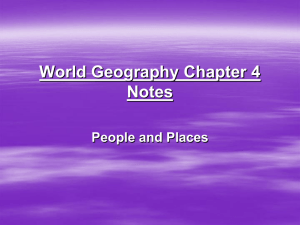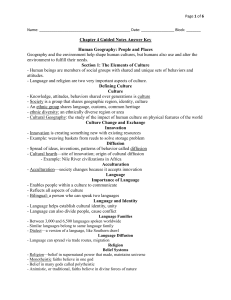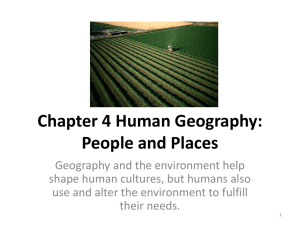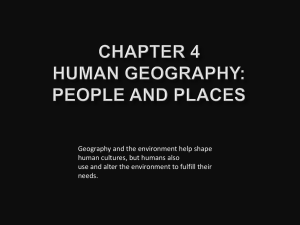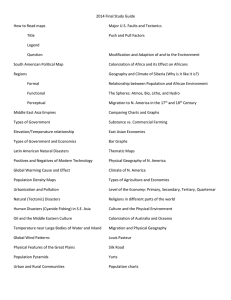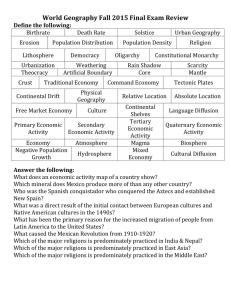World Geography Chapter 4 Notes
advertisement
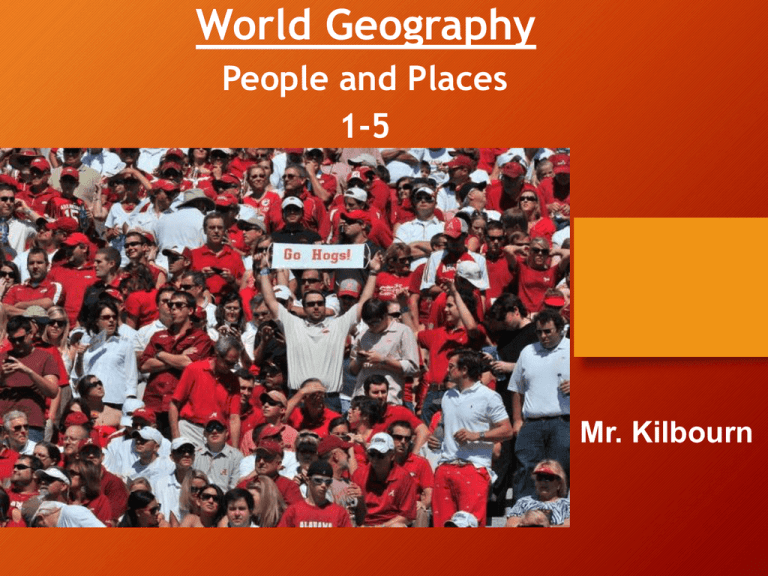
World Geography People and Places 1-5 Mr. Kilbourn Section 1 The Elements of Culture Defining Culture • Knowledge, attitudes, behaviors shared over generations is culture • Society is a group that shares geographic region, identity, culture • An ethnic group shares language, customs, common heritage Culture Change and Exchange • Innovation is creating something new with existing resources - Example: weaving baskets from reeds to solve storage problem • Spread of ideas, inventions, patterns of behavior called diffusion Culture Change and Exchange • Spread of ideas, inventions, patterns of behavior called diffusion Culture Change and Exchange • Cultural Hearth—site of innovation; origin of cultural diffusion - Example: Nile River civilizations in Africa • Acculturation— society changes because it accepts innovation Language • Language enables people within a culture to communicate • Language helps establish cultural identity & unity • Language can also divide people, cause conflict Language • Between 3,000 and 6,500 languages worldwide - Similar languages belong to same language family - Dialect—a version of a language, like Southern drawl • Language can spread via trade routes, migration Religion • Religion—belief in supernatural power that made, maintains universe • Monotheistic faiths believe in one god • Belief in many gods called polytheistic • Animistic, or traditional, faiths believe in divine forces of nature • Religion spreads through diffusion and conversion - Conversion—some religions try to recruit others to their faith Major Religions • Judaism Monotheistic; holy book called the Torah • Christianity -Evolved from Judaism; based on teachings of Jesus Christ - Largest religion—2 billion followers worldwide Major Religions • Islam - Monotheistic; based on teachings of Prophet Muhammad - Followers, called Muslims, worship God, called Allah - Holy book called the Qur’an Major Religions • Hinduism - Polytheistic; evolved in India around 5,000 years ago - Hindu caste system has fixed social classes, specific rites/duties • Buddhism - Offshoot of Hinduism; evolved around 563 B.C. in India - Founder Siddhartha Gautama, called the Buddha, or Enlightened One - Rejects Hindu castes; seeks enlightened spiritual state, or nirvana Section 2 Population Geography Worldwide Population Growth • Birth and Death Rates Number of live births per thousand population is the birthrate • Fertility rate—average, lifetime number of children born to a woman Worldwide Population Growth • mortality rate - Number of deaths per thousand people is the • Infant mortality rate—deaths under age 1 per 1,000 live births • Population growth rate, or rate of natural increase, figured by: - subtracting the mortality rate from the birthrate Worldwide Population Growth • A population pyramid shows a population’s sex, age distribution - Enables the study of how events (wars, famines) affect population Population Distribution • 2/3 of world’s population lives between 20°N and 60°N latitude • Dense where temperature and precipitation allow agriculture • Also dense along coastal areas and in river valleys • More sparse in polar, mountain, desert regions Population Distribution • Urban–Rural Mix - More than half of world’s population rural; rapidly becoming urban • Migration - Reasons for migrating sometimes called push-pull factors - Push factors (drought, war) cause migration from an area - Pull factors (favorable economy, climate) spur migration to an area Estimating Population Estimating Population • Population density is the average number of people living in an area Estimating Population • Carrying capacity is the number of organisms an area can support - affected by fertile land, level of technology, economic prosperity Section 3 Political Geography Nations of the World • An independent political unit, a state, or country: - occupies specific territory - controls its internal, external affairs • Nation—unified group with common culture living in a territory • A nation and state occupying same territory is a nation-state Types of Government • Democracy - citizens hold political power • Monarchy - Political power held by a king or queen • Dictatorship - a group or individual holds all political power • Communism - is a governmental and economic system - political, economic power held by government in people’s name Geographic Characteristics of Nations • Size - Physical size does not accurately reflect political, economic power • Shape - Shape affects governance, transportation, relations with neighbors • Location - A landlocked country has no direct outlet to the sea - may limit prosperity, as shipping and trade bring wealth - Hostile neighbors necessitate increased security National Boundaries • Natural Boundaries Formed by rivers, lakes, mountain chains • Artificial Boundaries - Fixed line, generally following latitude, longitude: - Example: 49 degrees N latitude separates U.S. from Canada - often formally defined in treaties Regional Political Systems • Countries divide into smaller political units like cities, towns • Smaller units combine regionally into counties, states, etc. • Countries may join together to form international units: • examples: United Nations, European Union NATO: North Atlantic Treaty Organization EU: European Union Section 4 Urban Geography Growth of Urban Areas • Urban geography is the study of how people use space in cities • Cities are populous centers of business, culture, innovation, change • Urban Areas - Urban area develops around a central city Growth of Urban Areas • suburbs—border central city, other suburbs - exurbs - have open land between them and central city • Central city plus its suburbs and exurbs called a metropolitan area • Urbanization—rise in number of cities, resulting lifestyle changes City Locations • Cities are often located near: - good transportation—lakes, rivers, coastline - plentiful natural resources • As a result, cities tend to: - become transportation hubs - specialize in certain economic activities Land Use Patterns • Basic land use patterns found in all cities: - residential (housing) -industrial (manufacturing) -commercial (retail) • Central business district (CBD)—core area of commercial activity • The Functions of Cities - Shopping, entertainment, government services - Educational, recreational, and cultural activities - Transportation is essential to accomplish functions Section 5 Economic Geography Economic Systems • Economy—the production and exchange of goods and services • Economies are local, regional, national, international • Geographers study economic geography by looking at: - how people in a region support themselves - how economic activity is linked regionally Types of Economic Systems • Economic system: way people produce and exchange goods, services • Four types of economic systems: - traditional, or barter, economy - command, or planned, economy - market economy, also called capitalism - mixed economy, a combination of command and market Types of Economic Activities • Subsistence agriculture food is raised for personal consumption Types of Economic Activities • market-oriented agriculture - Raising food to sell to others is called • Cottage industries - involve small, homebased industrial production • Large industrial production - comes from commercial industries Four Levels of Economic Activity • Primary - involves gathering raw materials for immediate use • Secondary - adds value to material by changing its form • Tertiary - involves business or professional services • Quaternary - provides information, management, research services The Economics of Natural Resources • Natural Resources—Earth’s materials that have economic value • Materials become resources when they can be turned into goods (3 types) • renewable - (trees, seafood) can be replaced naturally • nonrenewable - (metals, oil, coal) cannot be replaced • inexhaustible -(sun, wind) are unlimited resources Economic Support Systems • Infrastructure—basic support systems to sustain economic growth - power, communications, transportation systems - water, sanitation, and education systems - Communications systems and technology both critical to development Measuring Economic Development • Per capita income: average earnings per person in a political unit Measuring Economic Development • Gross national product (GNP)—statistic to measure the total value of goods, services produced by a country, globally • Gross domestic product (GDP) -statistic to measure the total value of goods and services produced within a country Measuring Economic Development • Developing nations have low GDP& per capita income • Developed nations have high GDP & per capita income
